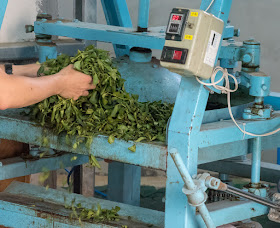What few people don't know is that Baozhong isn't the name of a cultivar, but a way of wrapping the tea in a piece of paper. Baozhong can be made with most tea cultivars that are suitable for Oolong. That's because Wenshan Baozhong is a partially oxidized tea and therefore belongs to the Oolong tea category.
The production process starts with the harvest of the leaves. Here, we see a machine harvest, because it's more and more difficult to find pickers for this tea.
The leaves are packed in big bags made of white fabric and are brought to the tea factory for processing.
The withering of the leaves can happen outside, usually in the shade, or in such an indoors installation equipped with fans and gas heaters. The advantage of this indoor solution is that it can be used even when it rains, which can be quite useful in northern Taiwan, where short (or long) showers happen frequently.
The leaves are then placed on these bamboo mats on these racks and rest for the night. There's little tossing in this Baozhong process (which is why its oxidation is rather light).
The next day, the leaves are weighed so that each batch would have the same weight.
These 2 machines are going to be used first. A tumbling oven on the right and then a rolling and pressing machine.
Notice the broom on the right. The floor is carefully cleaned before the work starts.
The tumbling oven is heated below 300 degrees Celcius and the leaves are tossed inside when it's very hot.
This high temperature kill green process lasts between 6 and 7 minutes approximately. The maker feels the leaves to know when they are ready.
The oven is pivoted downwards and empties the hot leaves on a flexible bamboo mat.
The leaves are then quickly placed on this machine that rolls and bruises the leaves in order to release their juice.
This process also lasts several minutes.
The leaves become very wet and compact as a result.
They are loosened up by hand
until they are evenly distributed on a mat. Then, the rack is left to rest while the other leaves are similarly processed.
These are the next 2 machines that will be used. A drying machine on the left and a roaster on the right.
After all the leaves have been heated and rolled/bruised, they now need to be dried. It starts with this machine where you place the leaves on top.
My job here was to distribute the leaves evenly on the rolling carpet. A revolving steel fork makes sure that the stacks of leaves are not too thick.
After a couple of minutes, the leaves come out and a rolled by hand in a white cloth.
This drying process is repeated two more times, but now the leaves land on a bamboo mat directly (instead of the white cloth).
The leaves are evenly distributed on the mat and placed back on the racks.
When all the leaves have been processed comes the drying in the roaster.
I transfer the leaves from the bamboo mat to the metallic roasting plate. The thickness on each plate must be the same so that the leaves dry in an even fashion.
The temperature was set slightly above 70 degrees Celcius and the time at 3 hours. This temperature won't roast the leaves, but simply dry them thoroughly. There's just one more step that needs to be done: taking away the stems on the leaves by hand. This step is usually made by different workers and for this maker it rarely happens on the same day as the process. That's why it can last several days to get a finished Baozhong tea.
While these leaves are drying, a new batch of freshly harvested leaves have arrived and the whole process starts anew for the tea maker! I didn't want to wait for the leaves to dry and went to drink this subtropical forest Baozhong from spring 2017! I'll show you how my brewing went next time... This picture shows the typical shape of twisted leaves of Wenshan Baozhong:
 |
| Subtropical forest 2 Wenshan Baozhong from Spring 2017 |



























I imagine the factory smells wonderful during this process. True?
ReplyDeleteSo true!
ReplyDeleteWhy no photos of the leaves being rolled by hand?
ReplyDeleteThere are photos of the leaves being rolled by hand, because the farmer didn't roll them by hand!
ReplyDeleteSorry, I must have misunderstood the caption under the photo which said," After a couple of minutes, the leaves come out and a rolled by hand in a white cloth." I thought from that that the twisted leaves are wrapped in cotton and then dried by roasting. I didn't think it was necessarily the farmer but would be someone else involved in making the tea.
ReplyDeletePerhaps I was also confused by once being told that the name Baozhong translated to "wrapped in paper and assumed that the wrapping - whether in cotton or paper - was part of the process of making this tea?
Thanks for clarifying the question/problem. I might have misused the verb 'roll'. Actually, under the caption you mentioned, you can see a white cloth filled with leaves coming out of the machine'. These leaves are collected in this cloth, which is then wrapped around them in order to create a kind of bag. This bag is then emptied at the entry of the same machine. This process is repeated twice before the leaves go to the roasting oven.
ReplyDeleteSo, this cloth has nothing to do with the name Baozhong. The wrapping comes after the roasting process.